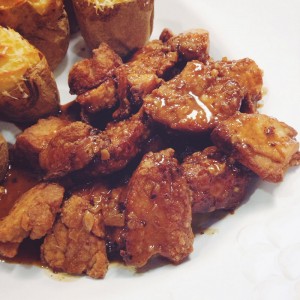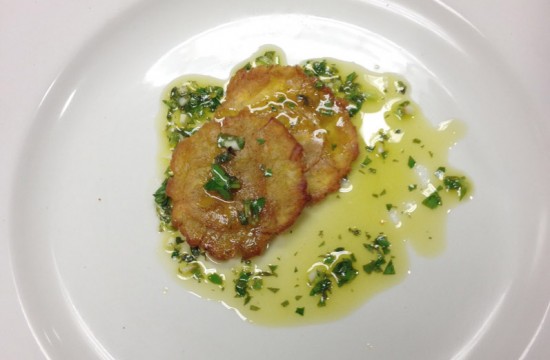Beyond mise en place, butchery and learning various techniques to build rich flavor, one of the most fascinating parts of culinary school is, quite simply, discovering new ingredients. It could be something as simple as chervil (a faintly licorice-flavored relative of parsley) or as strange as sweetbreads (a cut of offal derived from an animal’s thymus gland). Every new discovery is just a drop in the endless sea of flavors and ingredients available to the contemporary chef.
 They may look like chicken nuggets, but I assure you, they're sweetbreads.[/caption] Yet of all the unexpected ingredients I’ve discovered as a student, there is none so bizarre—and cool!—as caul fat. A natural, thin membrane that surrounds the internal organs of animals such as cows, sheep and pigs, this spiderweb of fat is most often harvested from pork.
They may look like chicken nuggets, but I assure you, they're sweetbreads.[/caption] Yet of all the unexpected ingredients I’ve discovered as a student, there is none so bizarre—and cool!—as caul fat. A natural, thin membrane that surrounds the internal organs of animals such as cows, sheep and pigs, this spiderweb of fat is most often harvested from pork.
In an industry that increasingly celebrates snout-to-tail or “whole hog” cooking, this natural casing for stuffed roasts adds moisture and flavor that will literally melt away while helping your dish keep its shape.
Rabbit is another of the more interesting ingredients we’ve had the chance to work with, a protein that many of my fellow students had never tasted before preparing it in class. From a butchery perspective, rabbit is among the most challenging animals to break down, due to its small frame and tiny bones. That said, once you understand the anatomy of the rabbit, it can help inform your butchery of much larger four-legged animals (which chefs usually buy in smaller cuts, rather than in their entirety).

For our most recent preparation, we wrapped a saddle of rabbit (a cut consisting of part of the backbone and both loins) around sautéed mushrooms and used the caul fat to wrap each little package. The fat cooked off beautifully, resulting in a striking golden-brown color while still maintaining moisture. However, interesting ingredients don’t only come from animals.
I’ve always enjoyed when my Dominican friends prepared tostones (a chip-like preparation of under-ripe plantains) for their dinner parties, but had never worked with platanos myself. I learned to carefully fry, flatten and re-fry these mildly sweet cousins of the banana, then topped it off with a delicious mojo sauce of cilantro and garlic.

Yet the real thrill of cooking with these adventurous ingredients goes beyond their novelty. Working with the unfamiliar can help us see new possibilities for preparing the everyday foodstuffs that we take for granted. Whether butter, chicken, potatoes, parsley or other basics we regularly stock in our refrigerators, it’s fun—and, professionally, important— to find ways to revisit these ingredients and take stock of their untapped potential.
With just a twist in technique, the ordinary can become as adventurous and exciting as any of the world’s most bizarre ingredients. So switch out your weekly steak for sweetbreads. Swap out parsley for chervil. Wrap your roasted chicken in caul fat. You never know where the next culinary adventure will take you.
Come see all the exciting kitchen action in person. Call (888) 997-CHEF to arrange a personal tour of ICE.




